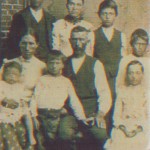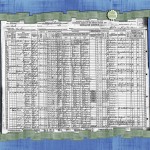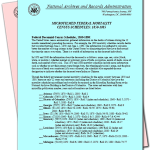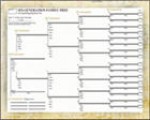Search results
Wondering How To Make A Family Tree – It Boils Down To Just Three Core Documents Your Searching For!
January 8, 2010 by Chris
Filed under Articles, Getting Started in Genealogy, Introduction to Genealogy, Lesson 4 Articles, Public Records
I receiv e great feedback every day by email. I wish more people would use the comments form below to share their experience. Please don’t hesitate to do so yourself. Regardless, keep the questions coming. I wanted to write right away and respond to everyone with the answer to a great question I received. One beginner genealogist wrote, “All this about government resources and talking to your family is great but it’s still not clear what I’m looking for.”
e great feedback every day by email. I wish more people would use the comments form below to share their experience. Please don’t hesitate to do so yourself. Regardless, keep the questions coming. I wanted to write right away and respond to everyone with the answer to a great question I received. One beginner genealogist wrote, “All this about government resources and talking to your family is great but it’s still not clear what I’m looking for.”
Has this same question crossed your mind?
Here’s the bottom line. You want to trace your ancestors back as far as you can. By that I mean identifying your direct ancestors (your parents, your grandparents, your great-great grandparents, etc.). Brothers and sisters, Aunts and Uncles, they are all great people to keep notes on but your core family tree is just the parents of the parents of the parents of you (and beyond).
When you find a direct mother or father in your lineage, you need to have documentation that proves that they are a part of your lineage You do this with formal documentation. Namely, birth certificates, marriage certificates, and death certificates. You’re ultimately searching for these three documents for every person on your family tree. This is how you do a family tree.
These documents will provide you with the critical information you need to go back to the previous generation. For example, a birth certificate will tell you who the parents were.
Does that help? Stick with it… you’re doing great. Just take it one generation at a time.
Making a Family Tree – What to Record
May 29, 2009 by Chris
Filed under Articles, Genealogy for Beginners, Getting Started in Genealogy, Introduction to Genealogy
 In case you are a novice, researching the genealogy of your family, you will know that you have to begin with yourself and move outward to your immediate family next. Keep a blank family tree and pedigree chart handy since you will have to record all the information there. You should record the following data for each person: name, date and place of birth, date and place of death, spouse, children and parents. If there is any other interesting fact, you can add that as well.
In case you are a novice, researching the genealogy of your family, you will know that you have to begin with yourself and move outward to your immediate family next. Keep a blank family tree and pedigree chart handy since you will have to record all the information there. You should record the following data for each person: name, date and place of birth, date and place of death, spouse, children and parents. If there is any other interesting fact, you can add that as well.
For relatives beyond grandparents you will need to consult secondary documents for data compilation.
Find out how to make a family tree
For affiliate info, visit: make a family tree
Software Solutions: How to Make a Family Tree?
May 22, 2009 by Chris
Filed under Articles, Genealogy for Beginners, Genealogy Technology, Introduction to Genealogy

Building a family tree is quite easy if you know the right way to make a family tree. You don’t have to make a lot of expensive long distance calls in a fact finding mission. There are plenty of family tree building software solutions readily available on the internet. They are very user-friendly and guide you step-by-step. The software will take all your data, such as photographs, family heirlooms, and documents and organize them.
Also there are online databases of family histories. In case you have gaps in your information you can search through them to find a particular family connection. This is a hassle free way of tracking down all your relatives.
Find out how to make a family tree
How to Make a Family Tree?
May 19, 2009 by Chris
Filed under Articles, Genealogy for Beginners, Genealogy Reports and Charts, Introduction to Genealogy
 Are you curious about your long lost relatives? You can easily find out about them with technologies that help you create a family tree. Do you want to know how to make a family tree ? A family tree is an account of your forefathers. Usually it is depicted by a genealogy map that shows family connections. Such a record usually contains vital information such as names of ancestors, their dates of birth, place of origin and occupation. Each person is connected to other people via different lines that designate different relationships.
Are you curious about your long lost relatives? You can easily find out about them with technologies that help you create a family tree. Do you want to know how to make a family tree ? A family tree is an account of your forefathers. Usually it is depicted by a genealogy map that shows family connections. Such a record usually contains vital information such as names of ancestors, their dates of birth, place of origin and occupation. Each person is connected to other people via different lines that designate different relationships.
For the data required to build a family tree, you may seek assistance from relatives or even from the internet. Grow your research as you grow your tree,visit make a family tree.
How to Make a Family Tree
January 7, 2009 by Chris
Filed under Blank Family Tree
 Some great advice from veteran genealogist on how to make a family tree. This is good advice on the “three documents” [birth, marriage, and death certificate]. However, the Federal Census’ comes up there in documentation. I’ve gotten more information from these when I couldn’t locate the other three.
Some great advice from veteran genealogist on how to make a family tree. This is good advice on the “three documents” [birth, marriage, and death certificate]. However, the Federal Census’ comes up there in documentation. I’ve gotten more information from these when I couldn’t locate the other three.
Finding out what the head of household’s occupation was gives you clues in other places to search! Having other family members names listed can help also. Parents that have disappeared on records, could be living with one of their children and found listed under that household. In-laws , grand children, etc. They may have done Their research, posted it online and it could make the connection you’re needing.
I found out one of my great grandmother’s remarried, hence I couldn’t find her death record. I was looking under the wrong name and hitting brick walls. Her second husband had also died, she spent her last days with her daughter and son-in-law.
If they [your ancestors] were farmers, they probably owned the land, land records are very helpful. If they was a doctor, you can go to the Retired American Physicians listing and get information there. The information is out there, one just needs to learn how to SEARCH the available records. The “three” are not always easily found.
Names change as you go back in history. For example, my great grandfather’s birth certificate shows him as simply “Henry”, his father called him “Senator”, his mother called him “Roy”. Some public records list him as “S. Roy or S.R.”. Bottom line being his birth states “Henry” and his death certificate “Roy” This as you can imagine, took some time to understand that this was all one in the same person.
Hard lessons learned, as I didn’t have the resources available to me as they are today. (We’re talking back in the late 60’s – 80″s) Everything was done by writing a letter and waiting patiently for a reply.
Plus this same individual [Henry/Roy] died in 1948, and was cremated. Family lost track of his ashes. I couldn’t find his burial any where, 30 years of searching and I finally hit pay dirt! He was buried with his wife when she died in 1962!! The only record to back this up was found in her file at the cemetery.
Just wanted to offer some other avenues that you may want to pass on.
Thanks again for the great advice. I’m sure this will be very helpful to new and seasoned genealogists working to fully understand how to make a family tree.
…
Now It’s Your Turn!
…
How to Make a Family Tree – The NARA
December 29, 2008 by Chris
Filed under Articles, Getting Started in Genealogy, Introduction to Genealogy, Public Records

Below is a great article about how to make a family tree through the eyes of a first time visitor to the NARA. In it the author discusses the value of the color guides used to assist researchers with the NARA’s most common records. Make sure you visit the link below to visit the source of the guides online. These resources will surely help you figure out how to make a family tree.
I recently made my first visit to the National Archives and Record Administration (NARA). This is one in a series of articles inspired by that visit to help you make your first visit to the National Archives.
Colored sheet finding aids
National Archives staff have prepared over 160 pages of finding guides to assist researchers with their most common records. These guides are printed on various hues of colored paper. They can be found on a rack in the lobby once you arrive at the Archives.
Not 100% sure the purpose behind the color. These might have been a way to help them stand out or perhaps a coding system. If I learn more I’ll update this post.
While the National Archives has decided not to put these guides online, fortunately, the Mount Vernon Genealogical Society has decided to fill this void. The Mount Vernon Genealogical Society is located in the Washington, DC suburbs where society members are lucky enough to make frequent visits to the National Archives. Some members work there.
Harold McClendon, publicity chair for the society, says,
To make these sheets available to everyone, the Mount Vernon Genealogical Society is placing all of the guides on its web site in PDF format. The guides are organized into the following categories: African Americans, Asian Americans, Census, Citizenship, Civilian Federal Employees, District of Columbia, Early Congressional Private Claims, Immigration, lands, Military, Native American and 1885 State and Territorial Censuses. As new sheets are issued by the National Archives, copies are being added to the web site.
To access these finding aids, go to http://mvgenealogy.org/NARA_Guides.html. McClendon recommends printing the guides related to your research.
As you review the guide, you will then be better able to determine the specific publication to review in search of the desired records. You might even find that the National Archives has publications that you never knew existed.
Thank you, Harold McClendon and the Mount Vernon Genealogical Society for extending this service to the genealogical community.
(This posting is from The Ancestry Insider.)
Great information thanks to the folks at The Ancestry Insider. Use the link above to visit the original post directly and browse their site overall. When trying to figure out how to make a family tree every little bit of information helps.
…
Where to Next?
Blank Family Tree with Step-by-Step Instructions
…
More:How to Make a Family Tree
November 13, 2008 by Chris
Filed under Genealogy Reports and Charts, Getting Started, Introduction to Genealogy
 Making Your Family Tree Chart is as Easy as 1-2-3! First, understanding exactly what a family tree is and what it looks like by downloading genealogy charts. This will provide clarity and direction. You are the first entry, then your parents, then your grandparents. If you have supporting documents, write in ink, otherwise, use pencil. Once you’ve exhausted your resources at home, it’s time to start searching online and elsewhere.
Making Your Family Tree Chart is as Easy as 1-2-3! First, understanding exactly what a family tree is and what it looks like by downloading genealogy charts. This will provide clarity and direction. You are the first entry, then your parents, then your grandparents. If you have supporting documents, write in ink, otherwise, use pencil. Once you’ve exhausted your resources at home, it’s time to start searching online and elsewhere.
Simply follow these three simple steps and you’ll be up and running with your family tree in no time. Start by getting yourself a Blank Family Tree Template
The Step-by-Step Genealogy Guide
- Family Tree Templates
- Exactly How To Make a Family Tree Chart
- Where to Find Birth, Death, and Marriage Certificates
- How to Deal With Name Related Issues Like Spelling Changes.
- And much more . . .
